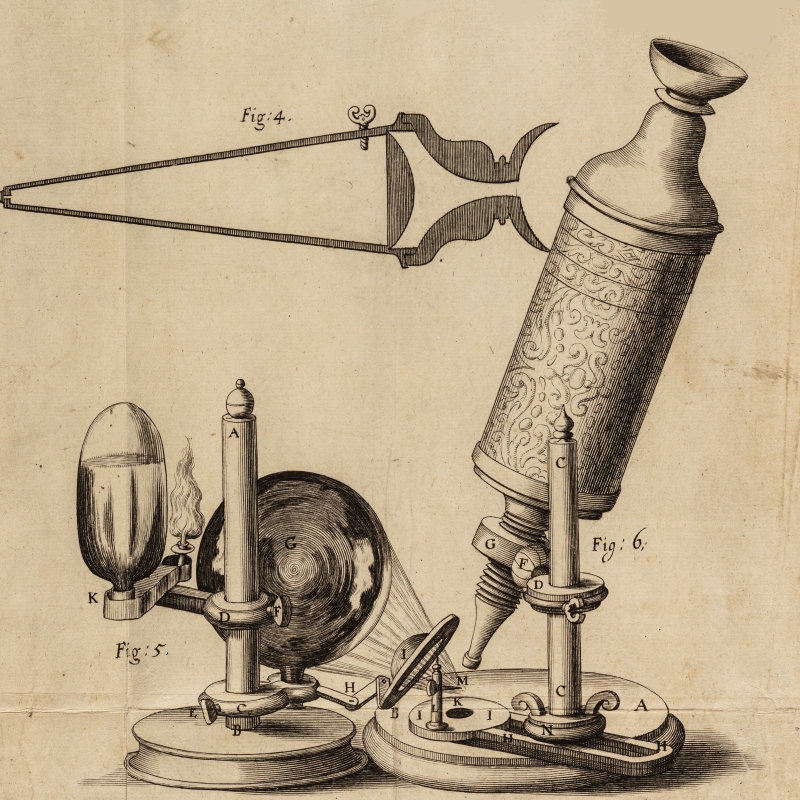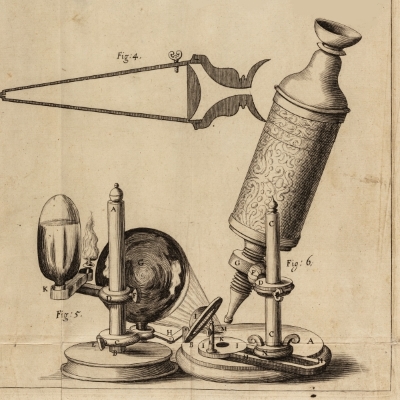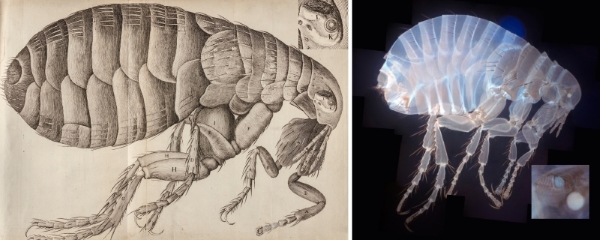Louisiane Ferlier shares her excitement at the launch of the Royal Society's digital version of Robert Hooke’s classic book 'Micrographia' (1665).

This week, the Royal Society is bringing you Summer Science Online. And as we celebrate science from home, I’m very excited to launch our digital version of Robert Hooke’s Micrographia (1665).
This great book of explorations of the very small, the very far and the very elusive, needs little introduction. Written and illustrated with 38 lavish copperplate engravings, Micrographia: or, some Physiological Descriptions of Minute Bodies made by Magnifying Glasses, with Observations and Inquiries thereupon, to spell out its full title, remains a landmark in the history of microscopy. Hooke, the Royal Society’s Curator of Experiments, describes in an engaging manner how he used his microscope to discover the structure of rocks, plants and, most famously, insects.

As always in science, Micrographia belongs within a larger context and is embedded in an international community. The observations Hooke compiled were largely based on requests made over the previous year by Fellows at meetings of the Society, and it’s also important to consider Hooke’s work alongside that of other wonderful microscopists such as Marcello Malpighi and Antonie van Leeuwenhoek.
In a previous blog instalment, I recounted how our copy of Micrographia was restored at the end of 2019. The spruced-up pages were then photographed by our digitisation partner, Bespoke Archive Digitisation, before we all went into lockdown. The resulting images are truly stunning – as you navigate through the digital version of Hooke’s book you will discover his precise and clear drawings. Hooke, an excellent scientific artist trained by court painter Peter Lely, oversaw the engraving process of the plates with great attention. The accuracy of his famous flea is even more striking when we compare it with an image produced using the latest microscope technology.

Right-hand image ©Dr Brad Amos, MRC Laboratory of Molecular Biology, Cambridge
The picture on the right was captured for the Royal Society Summer Science Exhibition 2010 by Dr Brad Amos FRS using the Mesolens, a giant microscope objective directly connected to a computer. Dr Amos, a biologist who designs optical instruments, demonstrated the workings of his Mesolens alongside Hooke’s original plate. To ensure that the specimens were comparable, he had to procure the flea specimen from the Department of Zoology at Cambridge University, as the human flea Pulex irritans has – thanks to the vacuum cleaner – been on the decline in the UK for decades.
You can play a decent game of spot the difference between the two images. Dr Amos pointed out that the recessed antennae, highlighted in the close-ups, could not have been visible to Hooke with the degree of magnification afforded by his microscope, and yet he represented the zone with astonishing accuracy.
The headline-grabbing flea does tend to overshadow the variety of specimens surveyed by Hooke, as well as the colourful quality of his scientific discourse. In his various observations, Hooke notes the magnification levels he used and how he prepared the specimens (I’m sure that entomologists have since developed better ways of immobilising ants than gluing their legs or drowning them in alcohol). This level of detail in describing the protocols reflected the Royal Society’s demands for reproducible experimentation. The structuring of the text into observations also puts the book back into its context of production: this is not a treatise of analytical science, but the work of a Curator of Experiments.
When recreating the book digitally, I paid particular attention to maintaining the original ratio between the plates and the rest of the book. Nothing conveys quite so powerfully that Hooke is playing up the effect of scale afforded by the microscope, than the experience of unfolding the louse to nearly twice the size of the book. The action of folding out a page in Turning the Pages is not a perfect simulation: a single press of this button: will unfold the full plate whereas the print version would have up to three folds to open individually, and some of the largest plates require navigating left or right with this button:
will unfold the full plate whereas the print version would have up to three folds to open individually, and some of the largest plates require navigating left or right with this button:
![]()
to bring them to the screen. I happen to think that this recreates quite well the experience of handling Micrographia in real life: the physical book requires manual interaction as the reader has to fold the plates in and out, and the plates are so large that you can barely take in the whole thing in one glance.
Various digital versions of Micrographia already exist online, but none of these offer the full package of a complete set of full-size plates, an index to navigate through the book, and the full machine-readable text, which you can search and download. In addition to this, the Royal Society copy of Micrographia includes manuscript notes pasted at the end of the book. These provide a reminder that the physical copy can sometimes be difficult to navigate: rather than flick back and forth between the text and the images, a seventeenth-century reader wrote down the descriptions of most of the plates to study them in context.
Written in French and English, we have not yet been able to find who wrote these notes. If you do recognise the handwriting, do let us know as there is always more we can learn about Micrographia! And if, like our mysterious annotator, you want to consider the plates separately with in-depth cataloguing, we have also created a special collection of all 38 plates in our Picture Library.
The Royal Society copy of Micrographia has been at the heart of the conversazioni and Summer Science Exhibitions many times over the years, and it truly is an exciting moment to be sharing it with everyone as part of Summer Science Online.







